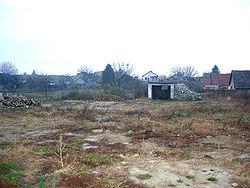
Bezdan
Encyclopedia

Backa
Bačka is a geographical area within the Pannonian plain bordered by the river Danube to the west and south, and by the river Tisza to the east of which confluence is located near Titel...
, Vojvodina
Vojvodina
Vojvodina, officially called Autonomous Province of Vojvodina is an autonomous province of Serbia. Its capital and largest city is Novi Sad...
, Serbia
Serbia
Serbia , officially the Republic of Serbia , is a landlocked country located at the crossroads of Central and Southeast Europe, covering the southern part of the Carpathian basin and the central part of the Balkans...
. It is situated in the Sombor
Sombor
Sombor is a city and municipality located in northwest part of Serbian autonomous province of Vojvodina. The city has a total population of 48,749 , while the Sombor municipality has 87,815 inhabitants...
municipality, West Bačka District
West Backa District
West Bačka District is a northern district of Serbia. It lies in the region of Bačka, in the autonomous province of Vojvodina. It has a population of 215,916...
. The village has a Hungarian ethnic majority and its population numbers at 5,263 people (2002 census).
History
It was first mentioned in 1305 under the name of Battyan, while in 1341 it was mentioned as Berčan. The village was destroyed during an OttomanOttoman Empire
The Ottoman EmpireIt was usually referred to as the "Ottoman Empire", the "Turkish Empire", the "Ottoman Caliphate" or more commonly "Turkey" by its contemporaries...
invasion in the 16th century. With the establishment of Habsburg
Habsburg Monarchy
The Habsburg Monarchy covered the territories ruled by the junior Austrian branch of the House of Habsburg , and then by the successor House of Habsburg-Lorraine , between 1526 and 1867/1918. The Imperial capital was Vienna, except from 1583 to 1611, when it was moved to Prague...
rule, the village was settled by Poles
Poles
thumb|right|180px|The state flag of [[Poland]] as used by Polish government and diplomatic authoritiesThe Polish people, or Poles , are a nation indigenous to Poland. They are united by the Polish language, which belongs to the historical Lechitic subgroup of West Slavic languages of Central Europe...
, Czechs and Germans
Germans
The Germans are a Germanic ethnic group native to Central Europe. The English term Germans has referred to the German-speaking population of the Holy Roman Empire since the Late Middle Ages....
. The first church in the village was built in 1755, and the current one was constructed in 1846.
Ethnic groups (2002 census)
- Hungarians = 2,983 (56.68%)
- SerbsSerbsThe Serbs are a South Slavic ethnic group of the Balkans and southern Central Europe. Serbs are located mainly in Serbia, Montenegro and Bosnia and Herzegovina, and form a sizable minority in Croatia, the Republic of Macedonia and Slovenia. Likewise, Serbs are an officially recognized minority in...
= 1,256 (23.87%) - CroatsCroatsCroats are a South Slavic ethnic group mostly living in Croatia, Bosnia and Herzegovina and nearby countries. There are around 4 million Croats living inside Croatia and up to 4.5 million throughout the rest of the world. Responding to political, social and economic pressure, many Croats have...
= 424 (8.06%) - YugoslavsYugoslavsYugoslavs is a national designation used by a minority of South Slavs across the countries of the former Yugoslavia and in the diaspora...
= 141 (2.68%) - others.
Historical population
- 1961: 6,813
- 1971: 6,427
- 1981: 6,085
- 1991: 5,472
- 2002: 5,263
- 2008: 4,318
See also
- List of places in Serbia
- List of cities, towns and villages in Vojvodina
http://en.wikipedia.org/wiki/1944-1945_killings_in_Ba%C4%8Dka

